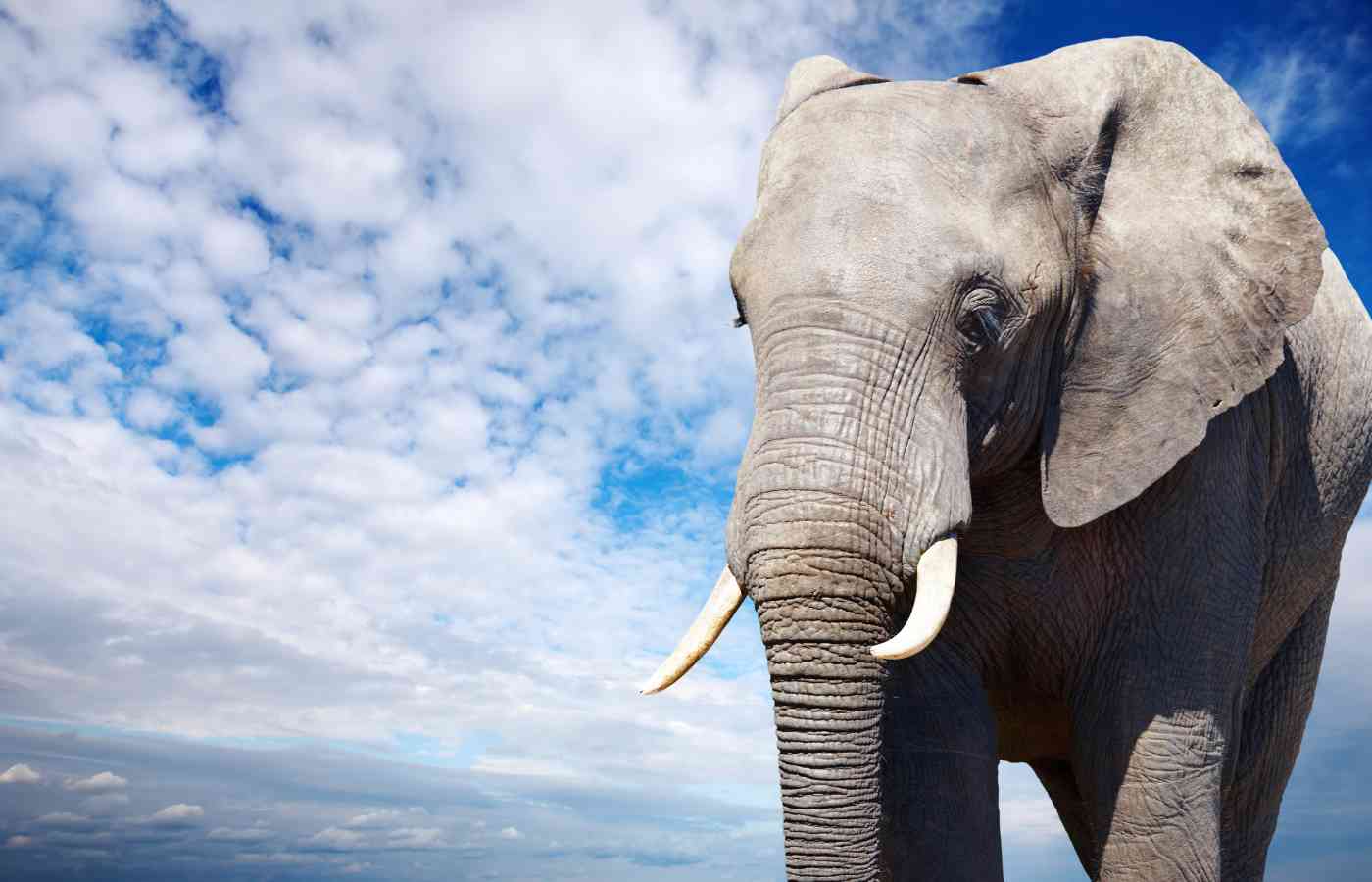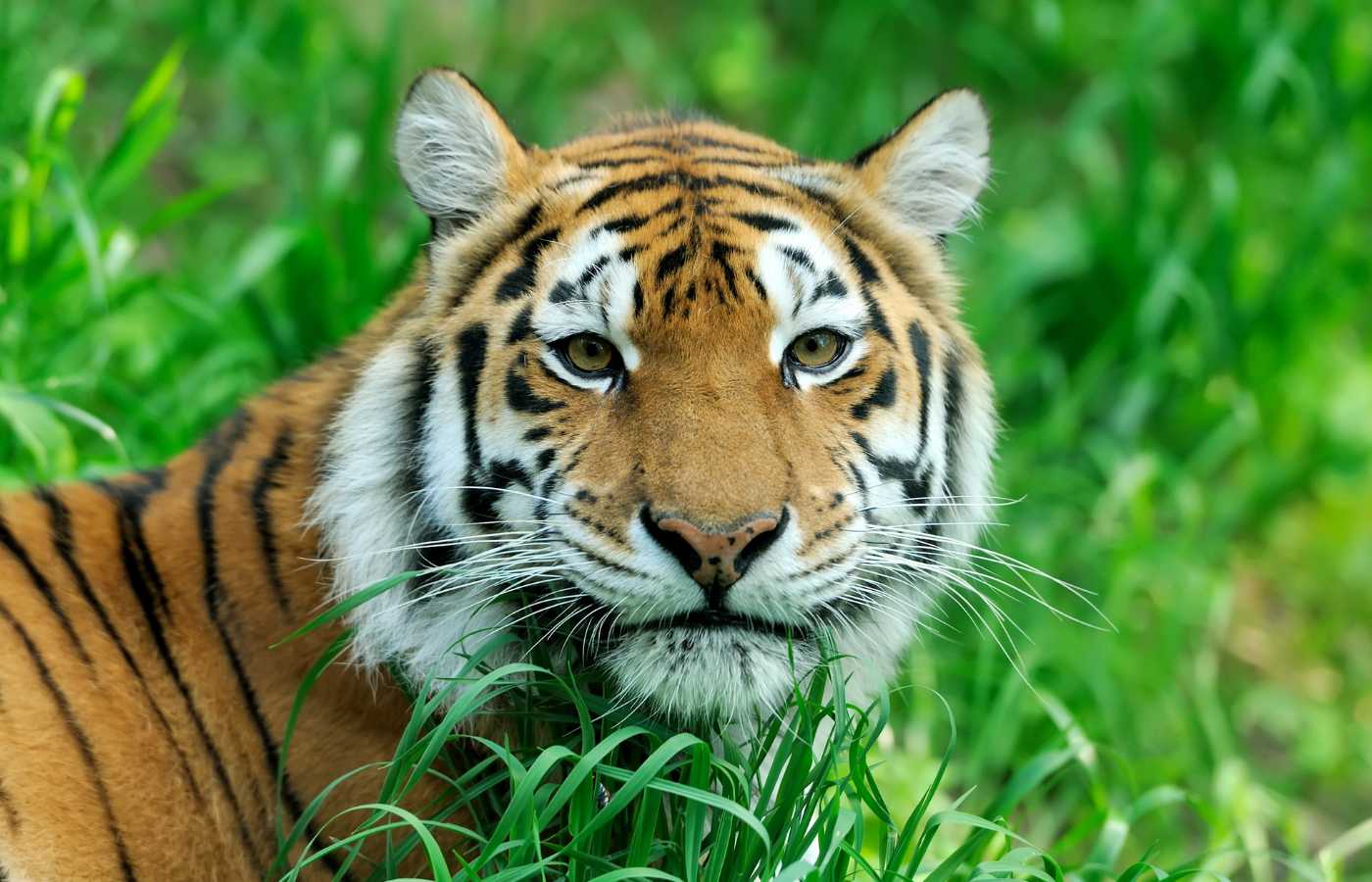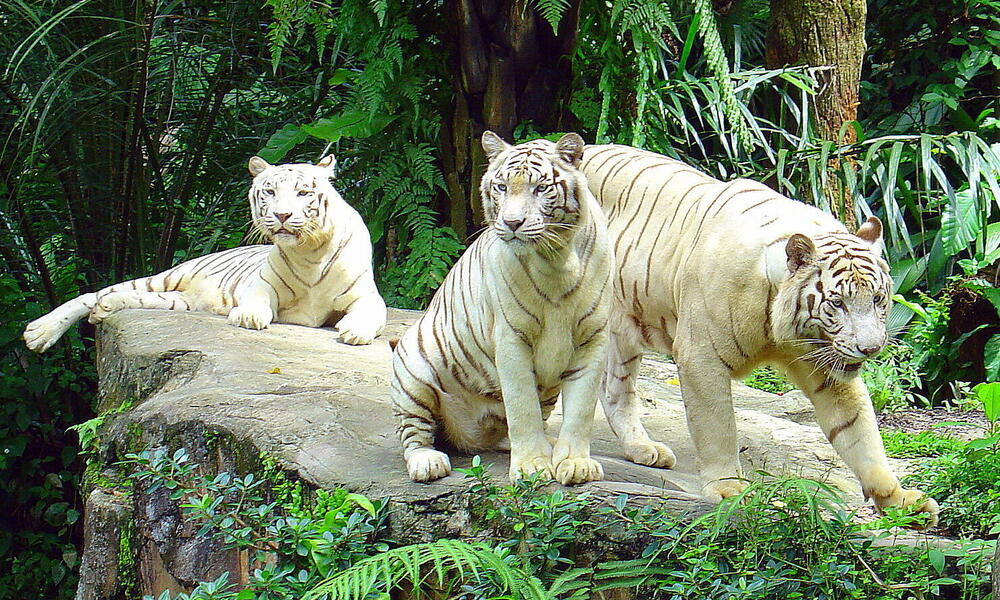
Saturday, August 12th is World Elephant Day, and there is no better time to learn about the largest land animal on earth. These majestic animals are sensitive, emotional, and highly intelligent.
But the elephant species is also endangered, and they could be extinct by the end of the next decade if steps are not taken to help them. Here are some interesting elephant facts that your kids will love.
SIZE
1. Elephants are the world’s largest land mammal. (Source: natgeokids.com)
2. On average, adult males weigh 18,000 pounds. Female elephants are smaller, weighing up to 8,000 pounds. (Source: natgeokids.com)
3. On average, African Elephants are about 10 feet tall at the shoulder. (Source: Nat Geo Wild)
4. Asian elephants are slightly smaller than African Elephants, reaching 9 feet tall and weighing 13,000 pounds. (Source: natgeokids.com)
5. The largest elephant ever recorded was 13 feet tall and weighted 24,000 pounds. (Source: Nat Geo Wild) Want to learn about another record-holder? Discover the fastest land animal in our Cheetah Facts for Kids.
6. Male elephants only reach their full size at 35-40 years. (Source: natgeokids.com)
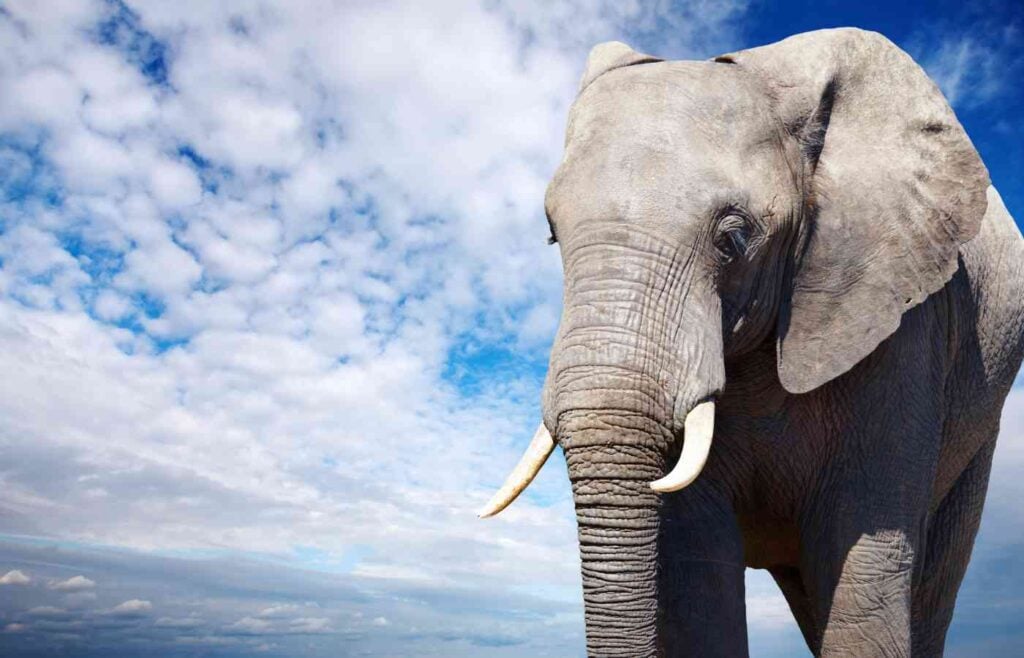
LIFESPAN
7. Elephants can live for up to 60-70 years! (Source: natgeokids.com)
8. The oldest elephant is Vatsala of Panna, who lives in India and is over 100 years old. (Source: The Indian Express)
FOOD AND WATER
9. Adults elephants eat about 220 pounds of food (70,000 calories) every day. (Source: Nat Geo Wild)
10. Adult elephants consume 50 gallons of water per day (Source: Nat Geo Wild)
11. Elephants spend up to 75% of their day, or 12-18 hours, eating. (Source: natgeokids.com)
12. Elephants eat grasses, leaves, shrubs, fruits, roots, twigs, branches, and tree bark, depending on the season and their habitat. (Source: natgeokids.com)
Similarly, Emperor Penguins have specific diets adapted to their cold environment. Learn more in our Emperor Penguin Facts for Kids.
13. Up to half of the food they eat leaves their body undigested. (Source: worldwildlife.org)
14. An elephant creates one ton of poop per week. (Source: worldwildlife.org)
Did you know red pandas play a vital role in their ecosystems too? Learn more in our Red Panda Facts for Kids.
15. Elephant poo is great for the environment. It keeps the soil fertile and helps disperse tree seeds. (Source: worldwildlife.org)
PREGNANCY AND BABIES
16. Adult females are pregnant for 22 months. (Source: natgeokids.com)
17. Elephants have the longest gestation period of any land animals. That means that female elephants are pregnant for longer than any other mammal. By comparison, human females are pregnant for 9 months. (Source: renderloyalty.com)
By comparison, rhinos also have long pregnancies—read more about them in our Rhino Facts for Kids.
18. A baby elephant is called a calf.
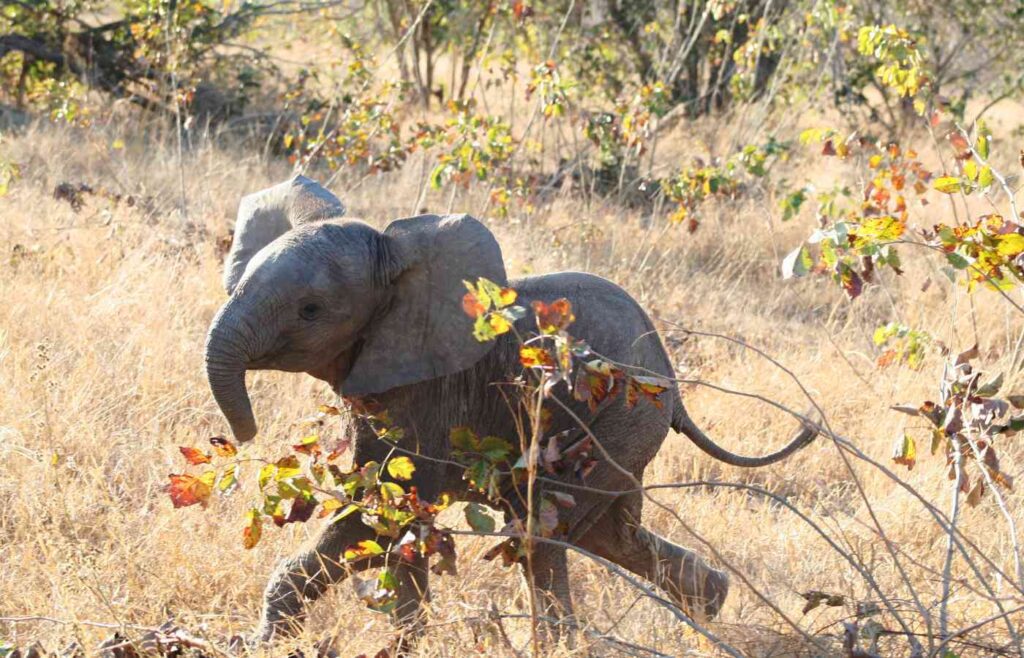
19. A baby elephant calf can weigh over 250 pounds. (Source: wwf.org.uk)
20. A baby elephant can stand within 20 minutes of being born. (Source: worldwildlife.org)
21. A baby elephant can walk within one hour of being born. (Source: worldwildlife.org)
22. After two days, young elephants can keep up with the herd. This is a survival technique that allows the elephants to keep moving around to find food and water. (Source: natgeokids.com)
SPECIES
23. There are three different species of elephants: The African Savanna Elephant (Bush), the African Forest Elephant and the Asian Elephant. The African Savanna Elephant is also knowns as the African Bush Elephant. (Source: natgeokids.com)
Similarly, wolves are divided into fascinating subspecies. Learn about their diversity in our Grey Wolf Facts for Kids.
24. Until recently, African Forest elephants were thought to be a subspecies of the African elephant, but new research discovered that they are actually a separate species entirely. (Source: natgeokids.com)
25. African Forest elephants live in the tropical forests on the continent of Africa. They have straighter tusks and more rounded ears than Savannah elephants. (Source: natgeokids.com)
EARS
26. You can tell the three species of elephants apart by their large ears. (Source: natgeokids.com)
Like elephants, many animals have unique adaptations to their environments. Check out how snakes adapt to their habitats in our Interesting Facts About Snakes.
27. African elephants have larger ears than the others. Their big ears are shaped like the African continent! (Source: natgeokids.com)
28. Asian elephants have smaller ears that are shaped like the Indian subcontinent. (Source: natgeokids.com)
29. Elephants can use their ears as big fans to radiate excess heat away from the body. (renderloyalty.com)
TRUNKS
30. Elephants are the only living animals with long trunks. (Source: Nat Geo Wild)
31. Elephants use their long trunks to suck up water to drink, smell their food, lift food to their mouth to eat, bathe, pick up or touch objects, trumpet warnings, and greet one another. (Source: wwf.org.uk)
Similarly, monkeys have evolved incredible ways to use their hands and tails. Discover how in our Monkey Facts for Kids.
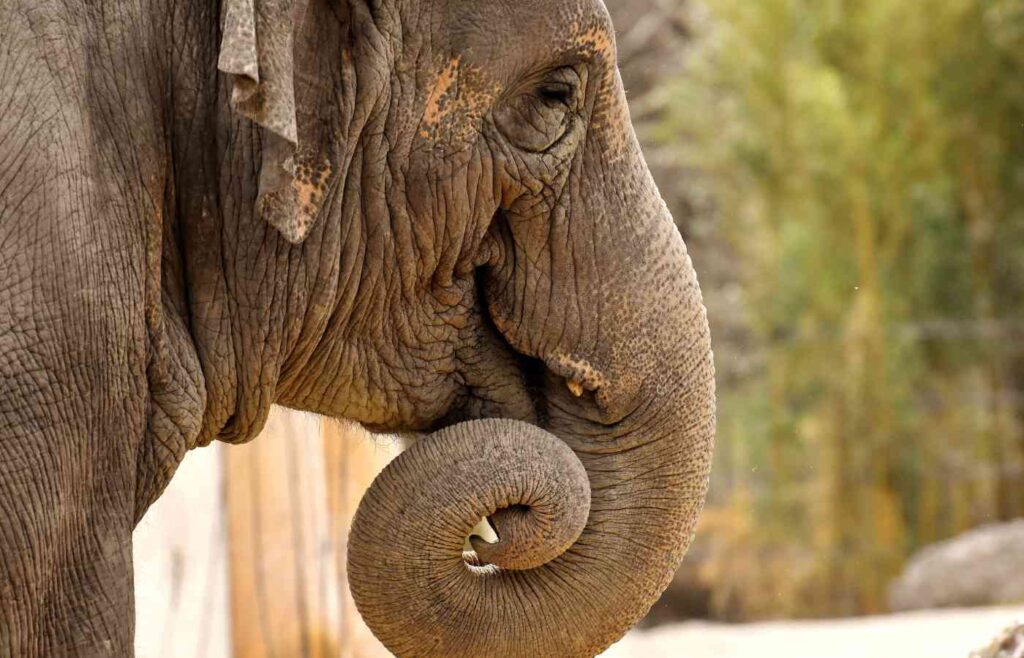
32. Elephants have around 150,000 muscles in their trunk. By comparison, a human has just over 600 muscles in the entire body. (Source: wwf.org.uk)
33. An elephant’s trunk is actually a fusion of their nose and upper lip. (Source: worldwildlife.org)
34. An elephant’s trunk is one of the most sensitive organs found in any mammal. (Source: wwf.org.uk)
35. An elephant can trunk weighs nearly 300 pounds. (Source: Nat Geo Wild)
36. An elephant’s trunk can lift objects nearly twice its size. (Source: Nat Geo Wild)
37. An elephant can use its trunk to pick up a peanut, shell it, blow the shell out and eat the nut. (Source: wwf.org.uk)
38. Elephant trunks can suck up four gallons of water at once and then spray it back out again. (Source: renderloyalty.com)
39. Elephants use their trunks to greet one another, reassure one another, and show affection. (Source: Nat Geo Wild)
40. African elephants have two ‘fingers’ at the end of their trunks, whereas Asian elephants have one. (Source: wwf.org.uk)
TUSKS
41. Elephant tusks are actually giant teeth. (Source: worldwildlife.org)
42. Their tusks first appear when an elephant is 2 years old. (Source: worldwildlife.org)
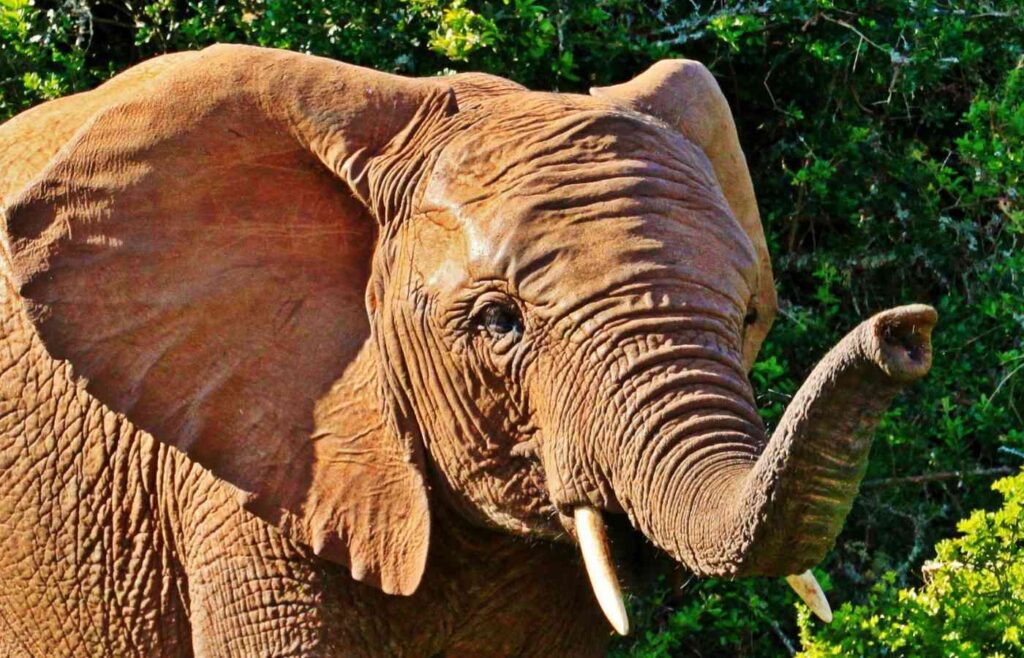
43. Young elephants get a first set of teeth and tusks that fall out and are replaced with adult tusks. (Source: Nat Geo Wild)
44. Elephant tusks never stop growing! They continue to grow throughout their entire lives. (Source: natgeokids.com)
45. Giant tusks are a sign of a very old elephant. (Source: natgeokids.com)
46. Elephant tusks can grow up to six feet long and weigh 50 pounds each. (Source: Nat Geo Wild)
47. Elephants have a dominant tusk. They are either left- or right-tusked, just like you are either right or left-handed! (Source: worldwildlife.org)
48. The dominant tusk is generally smaller because of wear and tear from frequent use. (Source: worldwildlife.org)
49. Both male and female African elephants grow tusks, but only male Asian elephant grow them. Female asian elephants do not have tusks. (Source: natgeokids.com)
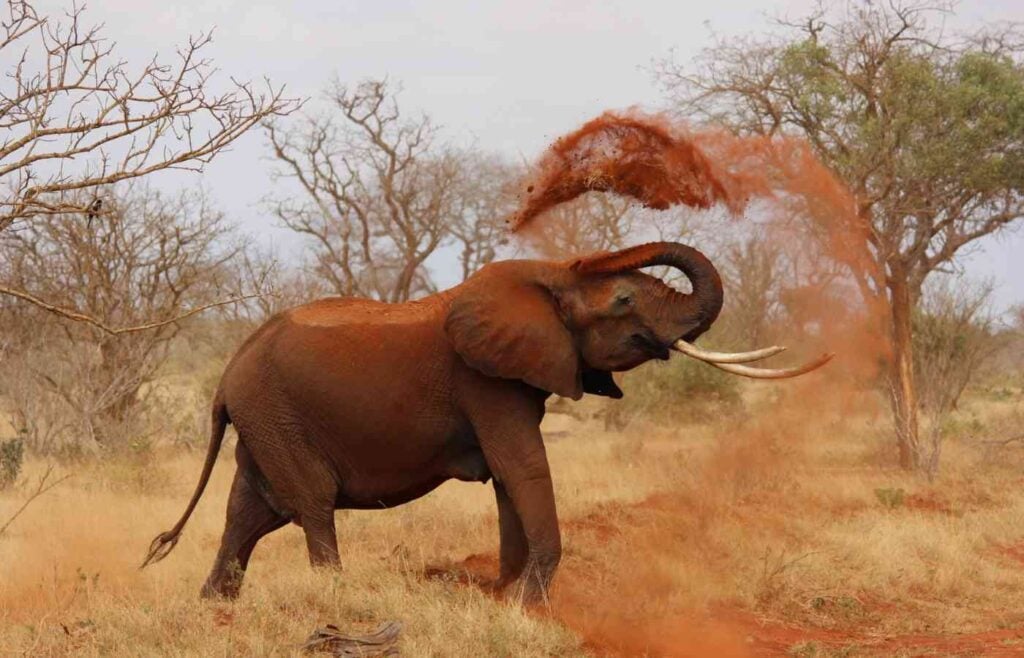
50. Elephant tusks help them get bark of trees, dig up roots, and defend themselves when fighting. (Source: worldwildlife.org)
51. Elephant tusks are made of ivory. (Source: worldwildlife.org)
52. Elephant tusks cannot grow back. Once it is broken, damaged or removed, it stays that way. It is just like human teeth in this way. (Source: worldwildlife.org)
SKIN
53. Elephant skin is 2.5 centimeters thick. That’s almost one inch! (Source: worldwildlife.org)
54. The folds and wrinkles in their skin can retain lots of water, which helps cool them down. (Source: worldwildlife.org)
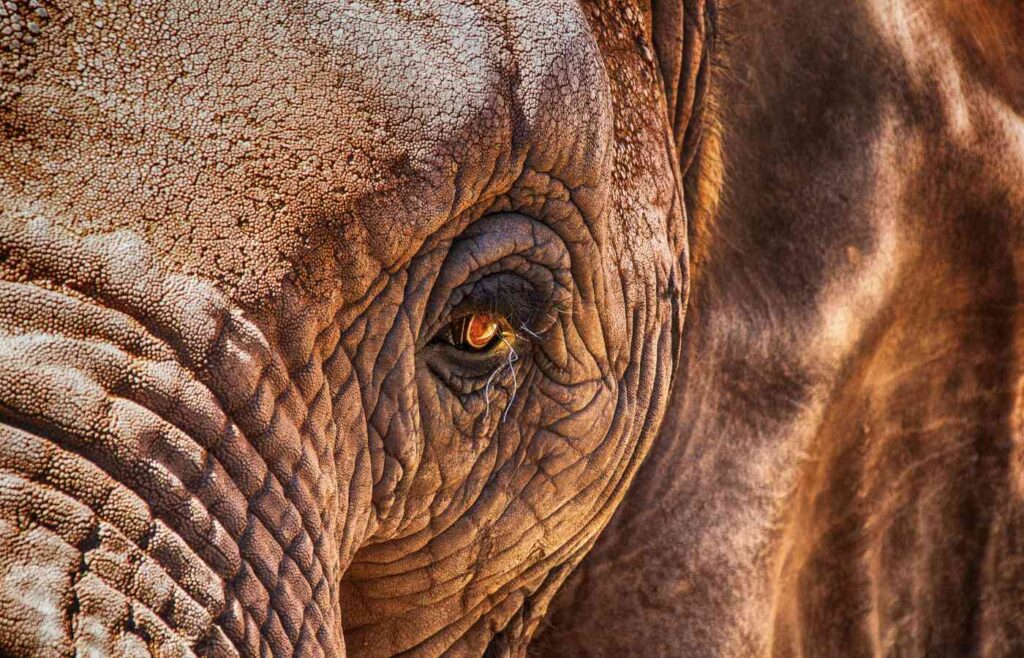
55. Elephants take regular dust and mud baths to keep their skin clean. (Source: worldwildlife.org)
56. Elephants use mud as their very own sunscreen. They throw mud on themselves to protect their skin from the hot, burning sun. (Source: natgeokids.com)
MOVEMENT
57. Elephants can walk very long distances, up to 80 miles in a day. (Source: renderloyalty.com)
58. Elephants can swim and float in deep water for many hours without stopping. (Source: natgeokids.com)
59. When swimming, they use their trunks as a snorkel! (Source: natgeokids.com)

60. Elephants are one of the only mammals that can’t jump because their legs are too slender to propel their weight upward. (Source: Nat Geo Wild)
61. Elephants can change the landscape around them by digging waterholes and creating footpaths. (Source: worldwildlife.org)
62. An elephant footprint can also enable a micro-ecosystem that, when filled with water, can provide a home for tadpoles and other organisms. (Source: worldwildlife.org)
COMMUNICATION
63. Elephants communicate with trumpet calls, some of which are too low for people to even hear. (Source: worldwildlife.org)
64. Elephants can ”talk” with their feet. They communicate through vibrations in the ground that travel faster than sound through air. (Source: worldwildlife.org)
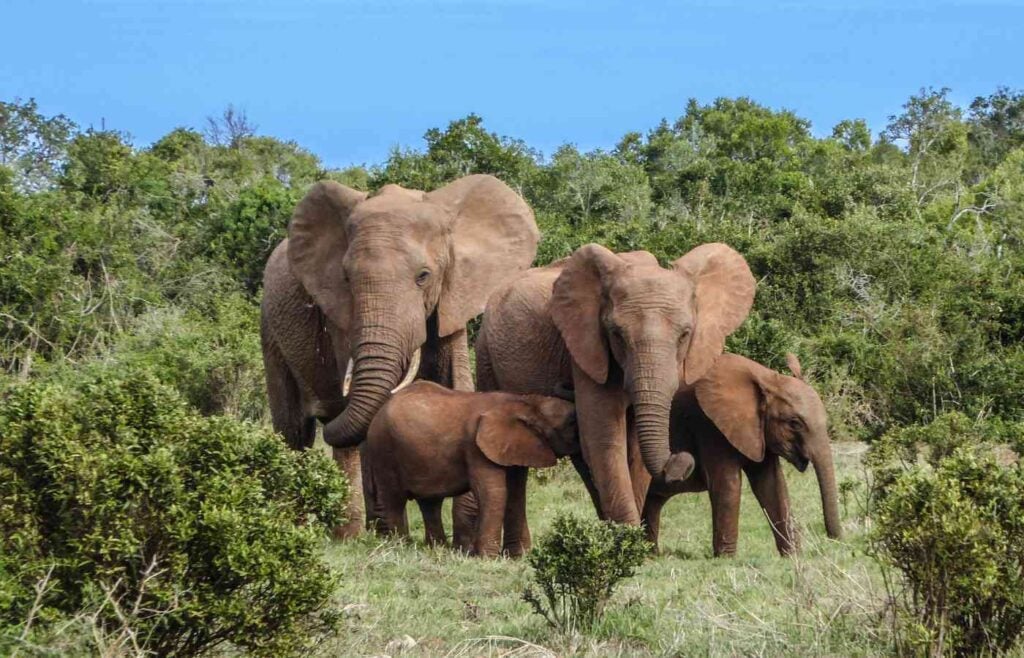
These deep-pitched sounds and vibrations in the ground travel through their feet, up the leg and shoulder bones, and into the middle ear. The elephants use the timing and strength of these signals to determine the sound’s direction and threat potential. (Source: renderloyalty.com)
65. Elephants also use body language, touch and scent to communicate with each other. (Source: worldwildlife.org)
HERD AND FAMILY LIFE
66. Female elephants generally stay with their herds for life. (Source: worldwildlife.org)
67. Males leave the elephant herd between the ages of 12-15. (Source: natgeokids.com)
68. Male elephants tend to live in isolation or in small bachelor groups. (Source: worldwildlife.org)
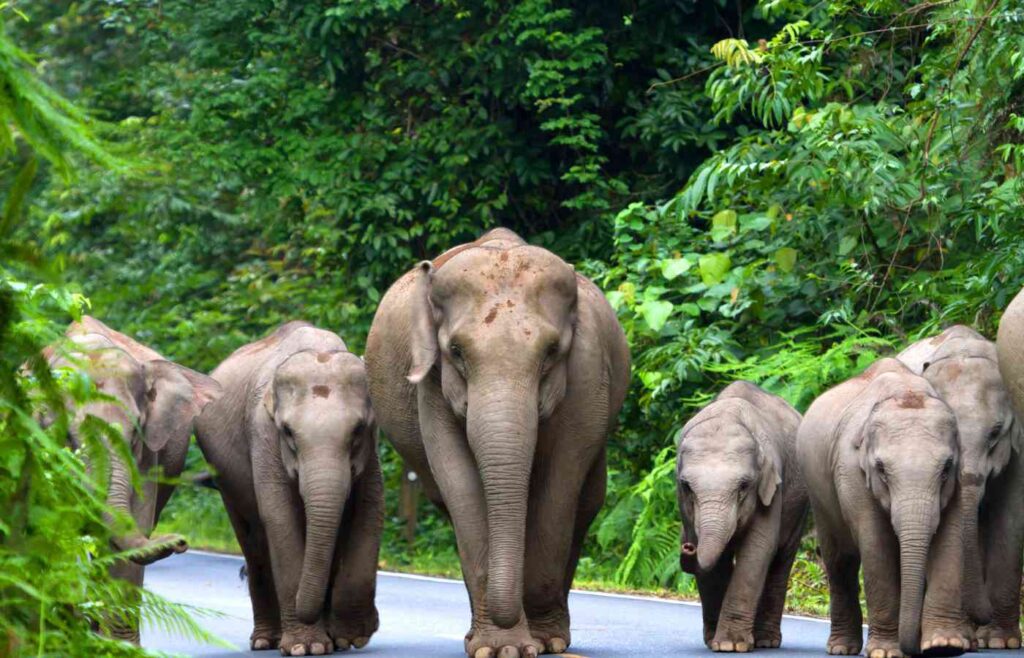
69. The basic family group has anywhere between 6 and 20 members, including the female matriarch and her calves and grand calves.
70. The family group forms a hierarchy based on age and knowledge of safe spaces for food and water. (renderloyalty.com)
71. Clans with older matriarchs have higher survival rates because they can use their memory of previous dangers and threats to avoid them now. (Source: Ted-Ed)
INTELLIGENCE
72. Elephants have the largest brain of any land animal. (worldelephantday.org)
73. Elephants have an incredible memory. Their temporal lobe (the part of the brain associated with memory) is actually larger and denser than human beings. As they say, “an elephant never forgets”. (Source: worldwildlife.org)
74. Elephants can remember distant watering holes that they visited many years before along their migration route. (Source: worldwildlife.org)
75. Elephants know every member of their herd and are able to recognize up to 30 companions by sight or smell. (Source: Ted-Ed)
76. Elephants can remember other elephants and humans who they met decades earlier. (Source: Ted-Ed)
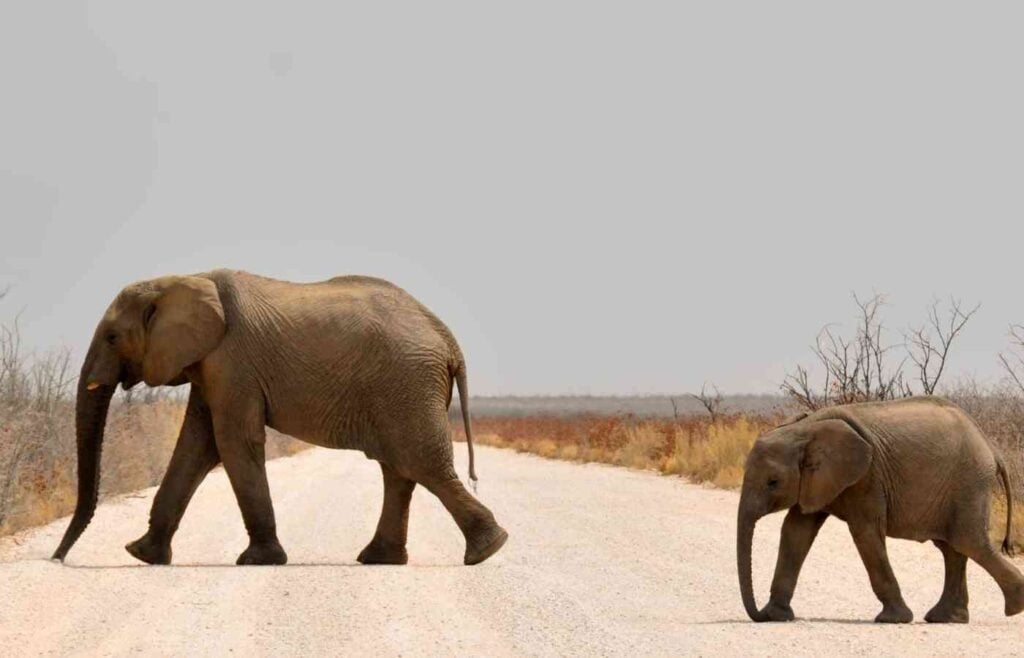
77. Elephants are the only non-human animals to mourn their dead. They perform burial rituals and returning to visit graves. (Source: Ted-Ed)
78. Elephant also mourn other unfamiliar elephants who have died by stroking carcasses that they pass in the wild. (source: renderloyalty.com)
79. It’s possible that elephants cry. The Washington Post described a young 10-year-old elephant visiting her mother’s corpse in Kenya and leaving with “the temporal glands on each side of her head… streaming liquid: a reaction linked to stress, fear and aggression.” (treehugger.com)
80. Elephant attacks on human villages often occur after significant poaching events, suggesting deliberate revenge as the motive. (Source: Ted-Ed)
81. Elephants can recognize 12 distinct tones of music and recreate melodies. (Source: Ted-Ed)
82. Elephants show empathy. One elephant refused to set a log down into a hole where a dog was sleeping, and other elephants have consoled injured humans. (Source: Ted-Ed)
83. Elephants are one of the few non-human mammals to suffer from post-traumatic stress disorder. (Source: Ted-Ed)
84. Elephants can create art by carefully choosing and combining different colors and elements. (Source: Ted-Ed)
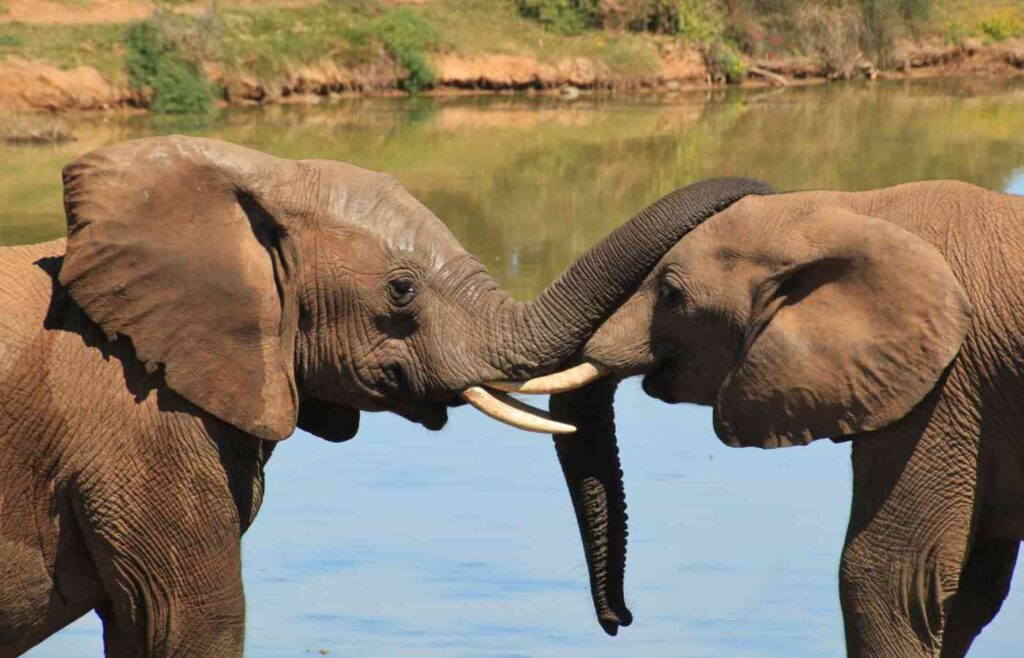
85. Elephants have grasped basic arithmetic, like how much fruit is in a basket after multiple changes. (Source: Ted-Ed)
86. Elephants have demonstrated an understanding of syntax and likely have their own language and grammar. (Source: Ted-Ed)
87. Elephants can distinguish between human languages. When elephants hear voices of a group they fear, they act defensively. (treehugger.com)
88. Elephants are one of the only mammals that can recognize their reflection in a mirror or water (dolphins, apes, and humans are the others). (Source: renderloyalty.com)
89. Elephants can use and make tools, such as using plants to scratch places on their bodies that they can’t reach. (Source: Nat Geo Wild)
90. In Mount Elgon National Park in Kenya, a group of elephants use their tusks to mine for salt in underground caves. They feel their way around with their trunks and eat the salts by breaking them off with their tusks. (Source: natgeokids.com)
HISTORY WITH HUMANS
91. The Asian elephant has lived alongside humans for over 4,000 years. (worldelephantday.org)
92. In Thailand, the elephant is a national icon. It has a national holiday designated in its honor and elephants can receive a Royal title from the King. (worldelephantday.org)
MISC.
93. Elephants hate ants! They avoid them entirely because ants can easily get into their trunk and irritate their sensitive nerve endings. (source: renderloyalty.com)
94. Contrary to popular belief, elephants don’t actually like peanuts very much! (Source: renderloyalty.com)
ENDANGERMENT
95. Elephants are endangered because they are being killed by humans for their ivory tusks. (Source: natgeokids.com)
Endangerment affects other iconic species like white tigers. Explore their stories in our White Tiger Facts for Kids.
96. An estimated 100 African elephants are killed each day by poachers seeking ivory, meat and body parts. (worldelephantday.org)
97. Around 90% of African Elephants have been wiped out in the past century. (Source: worldwildlife.org)
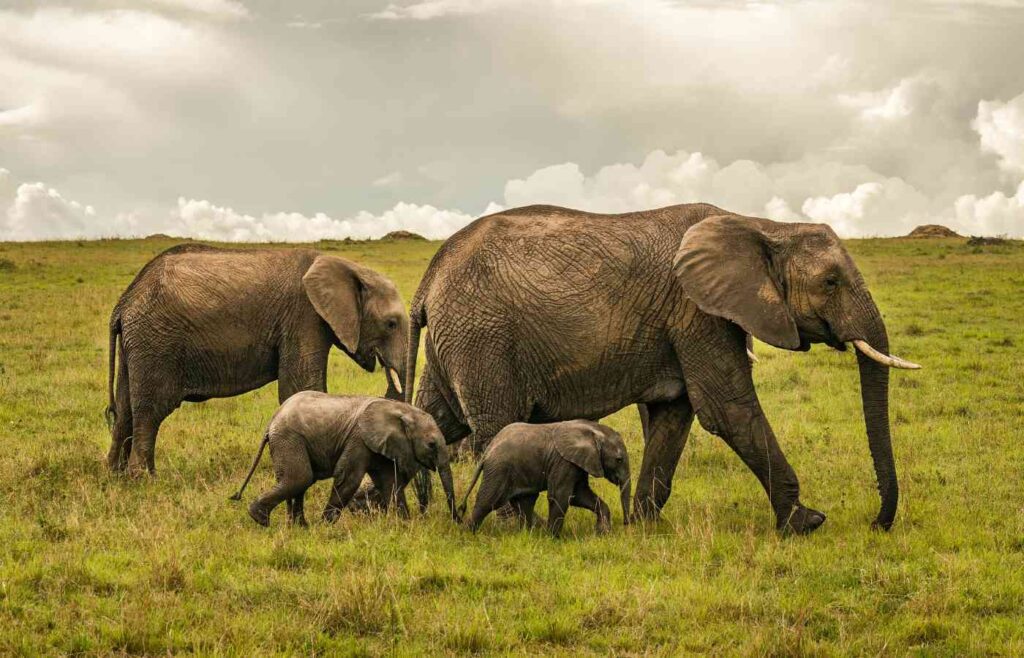
98. There are 415,000 wild African Elephants alive today, and 45,000 Asian Elephants. (Source: worldwildlife.org)
99. Asian elephants have also declined by about half in the last three generations. (Source: worldwildlife.org)
100. You can help elephants by not buying items containing ivory, buying elephant-friendly fair tree coffee, making a donation to an organization that helps elephants, and adopting an elephant through the World Wildlife Foundation.
Frequently Asked Questions About Elephants
Are elephants endangered?
Yes. Their biggest threat are humans who kill them for their ivory tusks. Habitat loss and conflict with local farmers are also threats for elephants.
Do elephants have good memory?
Yes, elephants have an incredible memory. They have the largest brain of any land animal (worldelephantday.org). Their temporal lobe (the part of the brain associated with memory) is actually larger and denser than human beings.
Elephants can remember distant watering holes that they visited many years before along their migration route. (Source: worldwildlife.org) They know every member of their herd and are able to recognize up to 30 companions by sight or smell. They can remember other elephants and humans who they met decades earlier (Source: Ted-Ed).
Elephants are the only non-human animals to mourn their dead. They perform burial rituals and returning to visit graves. (Source: Ted-Ed)
Are elephants afraid of mice?
There’s no evidence that elephants are afraid of mice. However, elephants hate ants! They avoid them entirely because ants can easily get into their trunk and irritate their sensitive nerve endings. (source: renderloyalty.com)
Where do elephants live?
Elephants are native to Asia and Africa. Botswana is currently home to more elephants than any other African country, and southern Africa is home to 70%, of the estimated remaining African elephants.
More than half of all wild Asian elephants are found in India, with around 10,000 in the north-east of the country. They also live in Vietnam, Cambodia, and China.
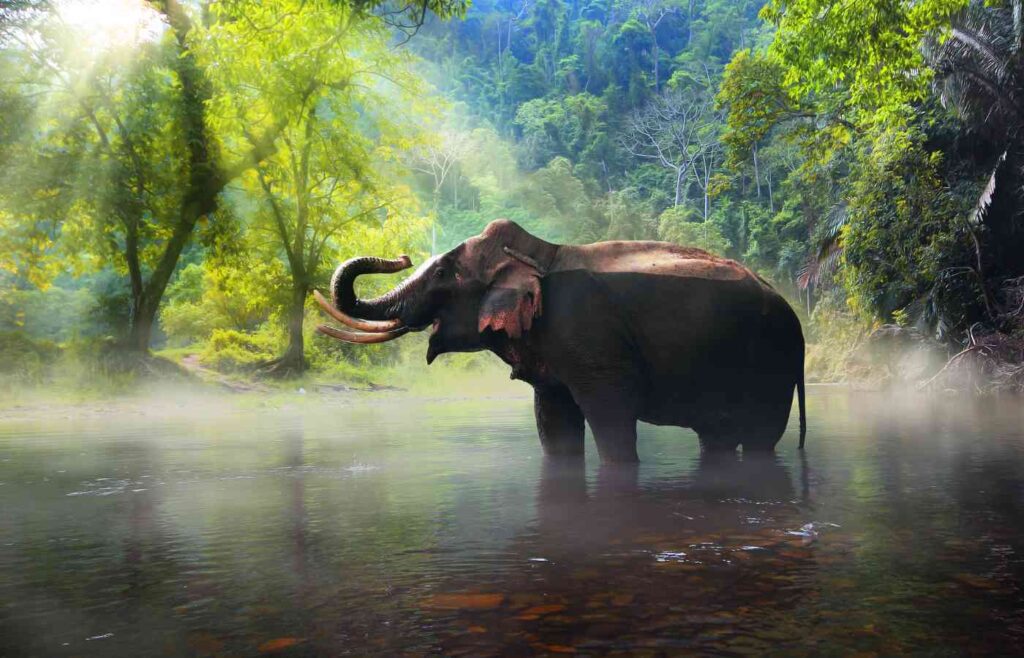
What do elephants eat?
Elephants eat grasses, leaves, shrubs, fruits, roots, twigs, branches, and tree bark, depending on the season and their habitat. (Source: natgeokids.com)
Can elephants swim in deep water?
Yes, elephants can swim and float in deep water for many hours without stopping. (Source: natgeokids.com) When swimming, they use their trunks as a snorkel! (Source: natgeokids.com)
Can elephants jump?
No, elephants are one of the only mammals that can’t jump because their legs are too slender to propel their weight upward. (Source: Nat Geo Wild)
How much do elephants weigh?
Elephants are the world’s largest land mammal. (Source: natgeokids.com) On average, an adult male African elephant weighs 18,000 pounds. Female elephants are smaller, weighing up to 8,000 pounds. (Source: natgeokids.com) Asian elephants are slightly smaller than African Elephants, reaching 9 feet tall and weighing 13,000 pounds. (Source: natgeokids.com)
The largest elephant ever recorded was 13 feet tall and weighted 24,000 pounds. (Source: Nat Geo Wild)
How much do elephants eat?
Adults elephants eat about 220 pounds of food (70,000 calories) every day. (Source: Nat Geo Wild) Adult elephants consume 50 gallons of water per day (Source: Nat Geo Wild)
Elephants spend up to 75% of their day, or 12-18 hours, eating. (Source: natgeokids.com) They eat grasses, leaves, shrubs, fruits, roots, twigs, branches, and tree bark, depending on the season and their habitat. (Source: natgeokids.com)
To help elephants, you can make a donation to an organization that helps elephants, and adopt an elephant through the World Wildlife Foundation.
Calie Herbst, Editor-in-Chief of Milwaukee With Kids, has spent over a decade combining her experiences as a parent of three to create a hub for Milwaukee’s family adventures.
Her decade-long teaching career in Milwaukee Public Schools and academic background, including a Master’s in Teaching from Marquette University and dual B.A.s in Sociology and Spanish from the University of Wisconsin – Madison, fuel her passion for inclusive and engaging family content.
Calie is also a recognized voice in local media, contributing to WISN Channel 12 News, WTMJ Wisconsin Morning News, Fox 6’s Real Milwaukee, and B93.3.
Discover more about Calie’s journey and editorial approach on her About Page and Editorial Policy Page.


